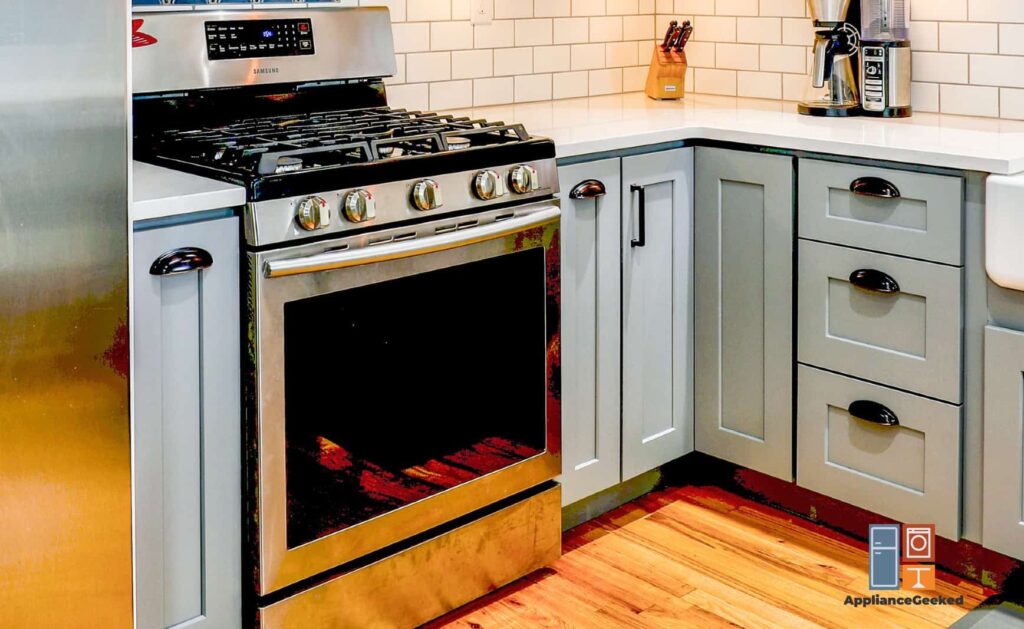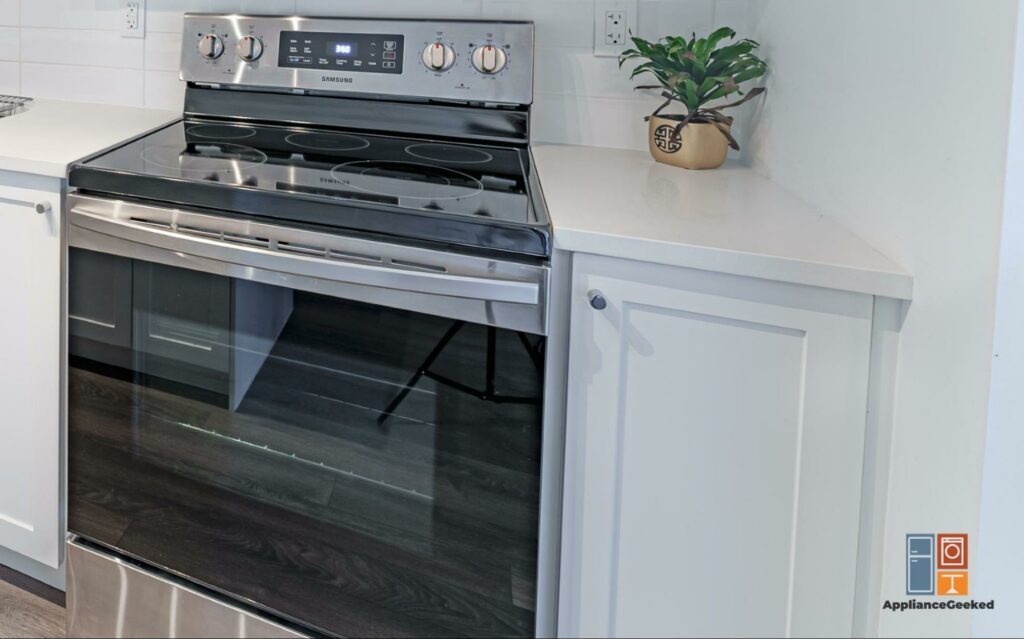
Believe it or not, the rancid smell of burning plastic in your new Samsung oven is normal. It happens when you burn in the protective oil coating of your unit.
In older units, burnt smells are often caused by poor maintenance or bad cooking practices. A deep clean should be enough to remove the smell.
If you have a faulty component, you must replace it to keep your oven operating at its peak performance. Lucky for you, most of the fixes are easy and can be performed in no more than 30 minutes.
No need to feel intimidated because we’ll walk you through every step.
Let’s get right into it.
Why does my Samsung oven smell like burning plastic?
A new Samsung oven might smell like burning plastic due to its protective oil coating. It is normal and non-harmful.
In older ovens, the smell can be a sign of improper care and maintenance, bad cooking practices, or component failure. Prompt action is required to prevent health and safety hazards.
How To Remove the Burnt Plastic Smell Out of My Oven
Heat up your new oven to the highest temperature for at least 20 minutes. Repeat the process two or three more times until it no longer smells like burnt plastic.
Inspect the bake and broil elements in your oven. Perform a continuity test and replace the faulty component to get rid of the smell.
Here, we will delve into all the possible causes of the burnt plastic smell in your Samsung oven. We will also show you how to resolve your problem and prevent it from happening again.
| Causes | Solutions | |
| New Samsung Ovens | Protective Oil Coating | Set it to the highest temperature for 20 minutes. Repeat the process two or three more times until the smell of burning plastic is gone. Let your oven cool down. Then, wipe the inside with a soft cloth dipped in warm, soapy water. Wipe your oven to remove the moisture inside. Keep the door open for a few minutes to let it dry. Plug in the oven once it fully dries. |
| Self-Cleaning Cycles | Burning Off of Food Residue and Gunk | Before running a self-cleaning cycle, open your windows and doors. Turn on a ventilation fan to get rid of the fumes and burnt smell. |
| Normal Use | Melted Plastic Containers | Most Samsung gas and electric ovens can use the cold method to remove melted plastic from the unit. Just pop a bag of ice inside the oven and wait for it to harden the plastic. Use a razor scraper to scrape off plastic inside your oven and on the racks. Clean your oven and let it fully dry before plugging it back in. Run a cooking cycle and check if the smell is still there. |
| Self-cleaning ovens should use heat to soften the plastic before prying it off. First, make sure your kitchen is well-ventilated. Open your windows and doors. Then, turn on the exhaust fan. Remove the racks and use a scraper to remove the melted bits of plastic. Turn on the oven and select the lowest heating setting. Turn it off once the plastic is soft and pliable enough. Next, use a wooden spoon to scrape off the plastic. Turn on the oven and run a cleaning cycle. | ||
| A Burned-Out Bake Element | Unplug the oven. Pull the oven out of the wall and unmount its back panel. Disconnect the spade terminals on the element. Unmount the power cord. Pull it out and set it aside. Remove the terminal block assembly. Then, cut across the insulation with a knife. Remove the burned-out element. Insert the new component into the opening and reattach its mounting screws. Reinstall the terminal block assembly and bracket. Mount the power cord and all its screws. Reconnect the spade terminals on the element. Reinstall the back panel and plug in your oven. Run a cooking cycle and check if the smell is gone. | |
| A Burned-Out Broil Element | Unplug the oven. Then, move it away from the wall to access the back panel. Unmount the back panel and set it aside. Disconnect the spade terminals and the temperature sensor molex. Carefully remove the oven door and set it aside. Unmount the temperature sensor and pull it out. Pull out the burned-out element and install the replacement into the terminals. Then, mount the temperature sensor. Reinstall the oven door. Connect the spade terminals and the temp sensor molex. Reinstall the back panel and plug in your oven. Start a cooking cycle to test if the smell is gone. |
New Samsung Ovens
All ovens are manufactured with a protective oil coating. The first few times your unit is exposed to heat, it will emit a rancid odor like burning plastic and a little bit of smoke.
Whether you have a new gas or electric Samsung oven, you must burn it in before using it to cook. It will remove the foul smell coming from your unit and prevent it from sticking to your food.
After running two or three cycles, the odor should start to fade. You can cook in your oven once the smell of burning plastic disappears.

Solution: To burn in a new Samsung oven, follow these steps:
- Step 1: Set your oven to the highest temperature for 20 minutes.
- Step 2: Repeat the process two or three more times until your oven no longer smells like burning plastic.
- Step 3: Let your oven cool to room temperature once it no longer smells like burnt plastic.
- Step 4: Clean your oven with a soft cloth dipped in warm, soapy water.
- Step 5: Wipe your oven dry. Then, keep the door open until it fully dries.
| Tips: • Check your new Samsung oven for any zip ties and remove all of them before running a burn-in cycle. • Don’t add food to your oven when you’re breaking it in. • Open the windows in your kitchen and make sure your space is well-ventilated. |
Self-Cleaning Cycles
During a self-cleaning cycle, your Samsung oven reaches high temperatures (approximately 932 °F (500 °C) to burn off food residue and hardened gunk. It may emit smoke and odd smells similar to burnt plastic throughout this process.
Although the smell is normal, it is unpleasant. You can prevent the odor from lingering in your kitchen by keeping your space well-ventilated.
Solution: Before running a self-cleaning cycle, open your windows and doors. Turn on a ventilation fan to get rid of the fumes and burnt smell.

Normal Use
If your oven isn’t new and you notice a burnt smell when you’re cooking, it’s most likely coming from melted plastic containers. When you use oven-safe cookware, you can prevent this from happening again.
A malfunctioning component may also emit a burnt smell when it malfunctions. If it’s not your cookware, it could be a burned-out heating element.
Melted Plastic Containers
Plastic should never go inside your oven at any temperature. It will warp and melt, leaving toxic fumes and a horrible mess inside your oven.
Inhaling burnt plastic is dangerous to your health. It can increase your risk of respiratory issues, heart disease, skin irritations, and more.
Thus, you must avoid using plastic and non-heat-resistant containers. Instead, use oven-safe cookware and bakeware because they can withstand high oven temperatures.
| What to Use | What to Avoid |
| • Heat-resistant glass cookware • Food-grade silicone containers • Oven-safe paper bakeware • Stainless steel skillets • Cast iron pans | • Heat-resistant plastic containers • General glassware • Plastic wraps • Styrofoam • Wood containers • Aluminum foil |
Cold Method
On most Samsung gas and electric ovens, you can use the cold method to remove melted plastic. That means you’ll need lots of ice to freeze the melted plastic and pry it off the oven.
Solution: To clean melted plastic in a Samsung oven, follow these steps:
- Step 1: Turn off your oven and unplug it.
- Step 2: Carefully remove the oven racks.
- Step 3: Use a razor scraper to pry the melted plastic off the racks.
- Step 4: Put ice bags on top of the melted plastic in your oven.
- Step 5: Close the oven door. Then, wait for the ice to melt and harden the plastic.
- Step 6: Scape off the hardened bits of plastic inside the oven.
- Step 7: Clean your oven with a damp, soapy soft cloth.
- Step 8: Wipe the oven and let it fully dry before plugging it back in.
- Step 9: Run a cooking cycle and check if the smell is still there.
| Tips: • You can use a 1:1 mixture of baking soda and water to clean strings of hardened plastic on your glass oven door. • Use a razor blade scraper to remove large chunks of melted plastic on the glass door. |
Hot Method
If you own a Samsung self-cleaning oven, use the hot method instead of the cold one. Instead of freezing the plastic, you must melt it further to remove it from your unit.
Ice can damage the coating in your self-cleaning oven. Thus, you must heat to soften the plastic and scrape it off your unit.
Solution: To clean melted plastic in a Samsung self-cleaning oven, follow these steps:
- Step 1: Keep your kitchen well-ventilated.
Open all the windows and doors. Then, turn on a ventilation fan to let the toxic fumes out of your space.
- Step 2: Pull out the racks. Use a scraper to chip off the melted bits of plastic.
- Step 3: Turn on the oven and select the lowest heating setting.
- Step 4: Check if the plastic has softened a bit.
- Step 5: Turn off the oven and use a wooden spoon to scrape off the plastic. Be careful because the plastic and the oven could still be hot.
- Step 6: Turn on the oven again. Run a self-cleaning cycle to blast away the residue.
Faulty Bake Element
Your oven’s bake element can emit a burning smell if it malfunctions. It is your unit’s main heat source.
If it malfunctions, your oven can experience temperature problems(Samsung oven temperature problem). You must replace the faulty component to keep your oven running at peak performance.
Solution: Perform a continuity test using a multimeter. If the bake element has no continuity, it needs a replacement.
- Step 1: Unplug the oven, or turn it off at the circuit breaker.
- Step 2: Move the oven to access the back panel.
- Step 3: Unmount the back panel and set it aside.
- Step 4: Disconnect the spade terminals on the bake element.
- Step 5: Set a multimeter to the ohms setting. Touch each probe to a terminal on the element.
- Step 6: Read the results.
A good bake element will have 10 to 50 ohms. If it has no reading, the component is malfunctioning and requires a replacement.
- Step 1: Unplug the oven, or turn it off at the circuit breaker.
- Step 2: Move the oven to access the back panel.
- Step 3: Unmount the panel and set it aside.
- Step 4: Disconnect the spade terminals on the bake element.
- Step 5: Unmount the power cord. Then, pull the cord out and set it aside.
- Step 6: Unmount the terminal block assembly and its bracket.
- Step 7: Cut across the insulation with a knife.
- Step 8: Unmount the old component and remove it from its housing.
- Step 9: Insert the new element into the opening and reinstall the mounting screws.
- Step 10: Reinstall the terminal block assembly and bracket.
- Step 11: Mount the power cord and all its screws.
- Step 12: Reconnect the spade terminals on the element.
- Step 13: Reinstall the back cover.
- Step 14: Turn the power back on.
- Step 15: Run a cooking cycle and test if your oven heats up.
Faulty Broil Element
The broil element is one of two heating sources in your oven. Located at the top of your unit, it cooks your food through high, direct heat.
If it burns out, it can also emit a strange smell like burning plastic. Once you replace the faulty component, the smell should go away.
Solution: Check for continuity using a multimeter. Then, replace the broil element if it shows no continuity.
- Step 1: Unplug the oven or turn off the circuit breaker.
- Step 2: Move the oven to access the back panel.
- Step 3: Remove the back panel and set it aside.
- Step 4: Disconnect the spade terminals on the broil element.
- Step 5: Get a multimeter and set it to ohms. Test for continuity by touching each probe to a terminal on the element.
- Step 6: Check the reading.
A good broil element will reflect 10 to 50 ohms on the multimeter. If it is malfunctioning, it will show no continuity.
- Step 1: Unplug the oven or turn off the circuit breaker.
- Step 2: Move the oven to access the back panel.
- Step 3: Unmount the back panel and set it aside.
- Step 4: Disconnect the spade terminals from the element.
- Step 5: Unplug the temperature sensor molex.
- Step 6: Disassemble the oven door and set it aside. Then, remove the racks, trays, and other accessories.
- Step 7: Unmount the temperature sensor and remove it.
- Step 8: Remove the mounting screws on the burned-out element, and carefully pull it out of the oven.
- Step 9: Install the new component. Lock it in place with its mounting screws.
- Step 10: Mount the temperature sensor.
- Step 11: Reinstall the oven door and put the racks back inside.
- Step 12: Reconnect the spade terminals and the temp sensor molex.
- Step 13: Reinstall the back panel.
- Step 14: Plug the oven back in and turn it on.
- Step 15: Start a cooking cycle and check if the smell is gone.
Frequently Asked Questions
Before cooking in your oven, you need to burn away its protective oil coating to prevent the smell from sticking to your food. You might have to do this two or three times until the burnt odor dissipates.
The smell of burning plastic in a new oven is normal and not harmful. It’s caused by the protective chemical coating applied during the manufacturing process.
However, you should still ventilate your kitchen while your oven is burning off its oil coating. Open the windows and doors in your kitchen to let out that strange smell.
Inhaling burnt plastic fumes is dangerous for your health. It can increase your risk of respiratory problems, heart disease, asthma, skin irritations, headaches, and more.
Over time, it can also damage different organs in your body, including your liver, kidney, and reproductive system. In rare cases, inhaling burnt plastic fumes can be fatal, especially if you have an existing respiratory condition.
If you are ever exposed to these toxic fumes, we recommend contacting a medical professional.
Typically, the burnt smell in your new oven should slowly dissipate after two or three cycles. However, you might have to repeat the burn-in process several times until the smell fully fades.



